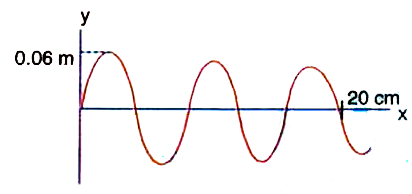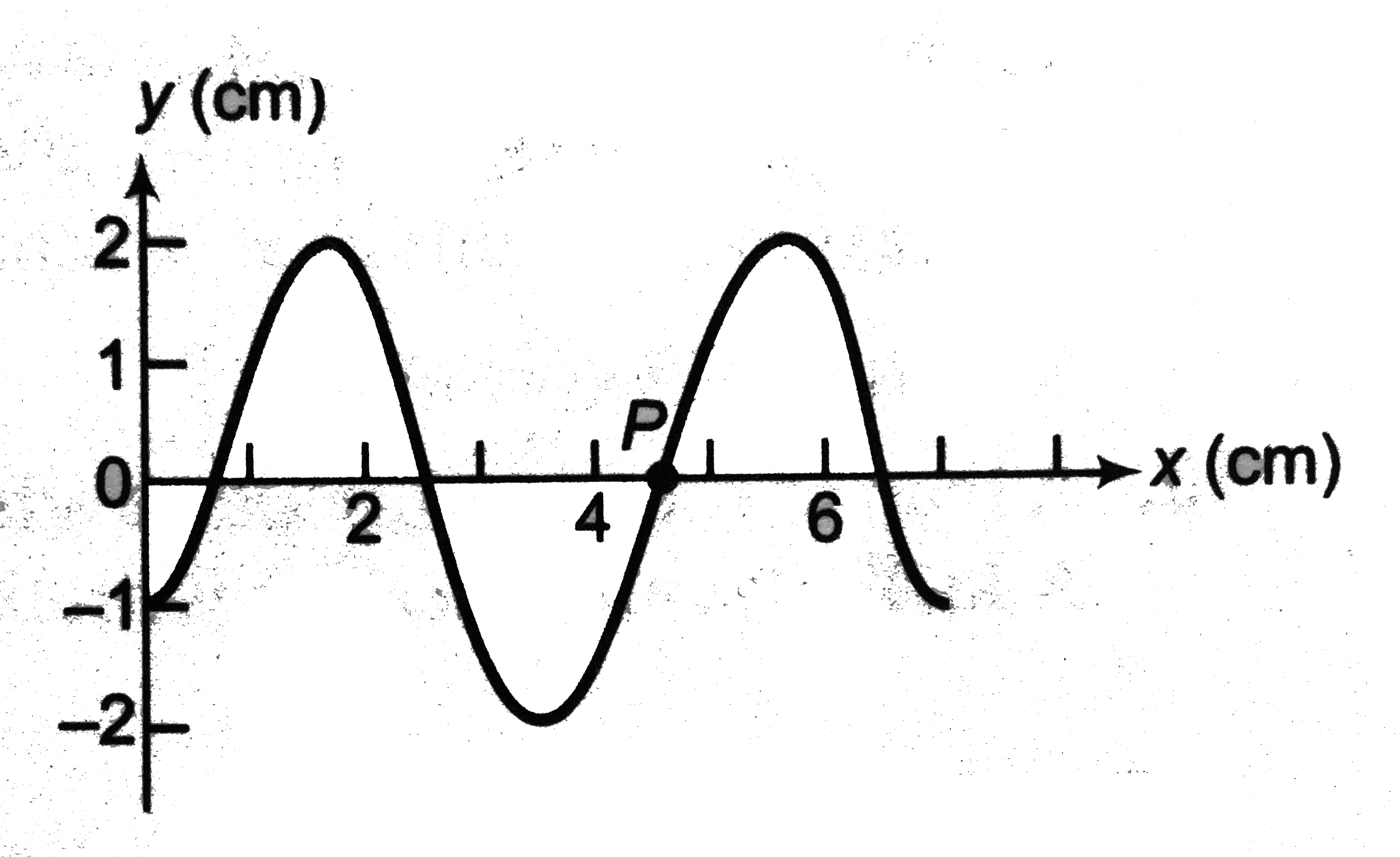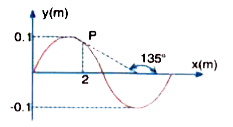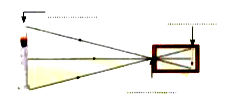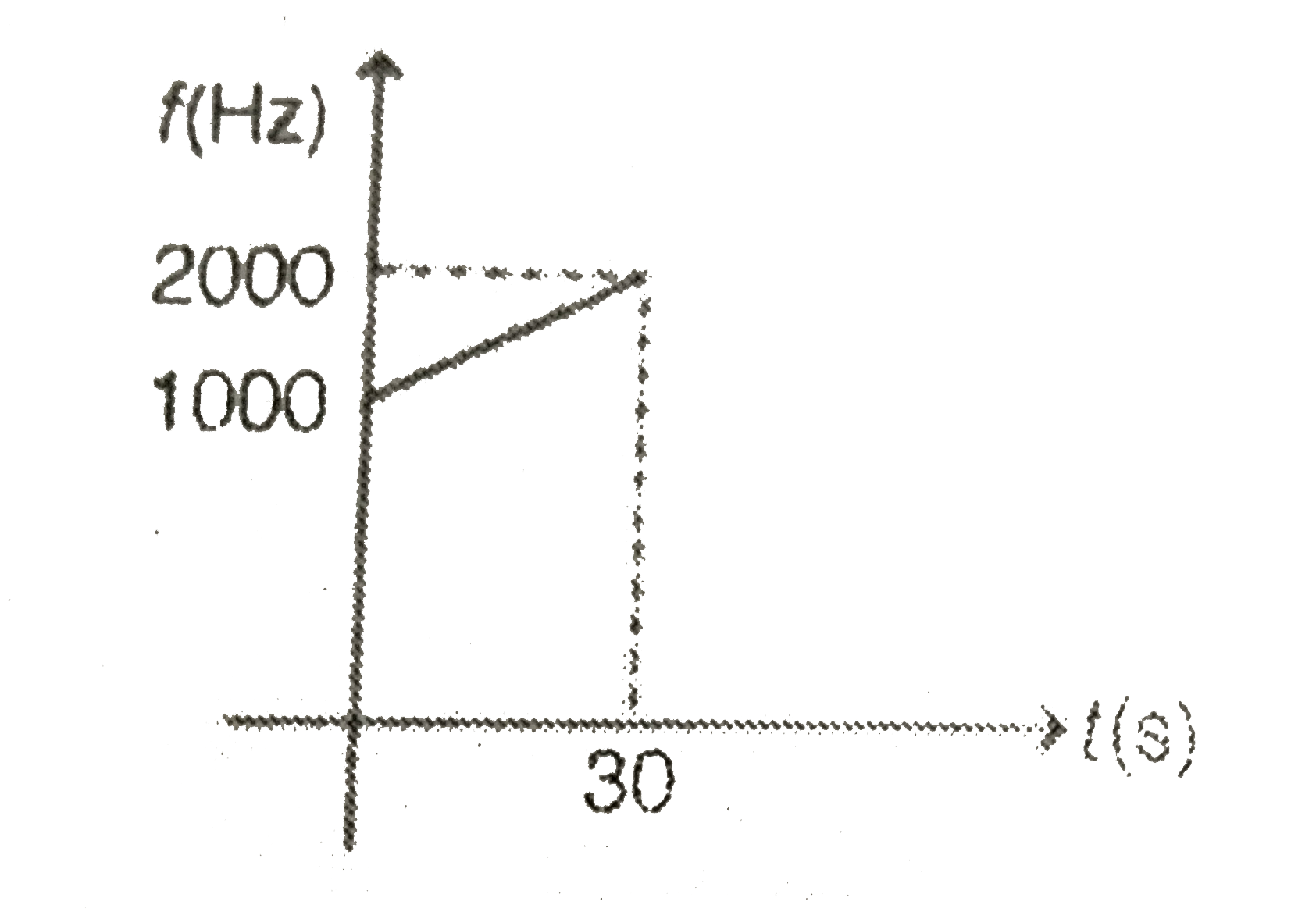PROBLEMS (LEVEL - II) from AAKASH SERIES WAVE MOTION AND SOUND for Class 12
| Class 12 | PHYSICS |
| Chapter | WAVE MOTION AND SOUND |
| AAKASH SERIES | PROBLEMS (LEVEL - II) |
| Medium | English |
| Academic Year | 2023-2024 |
Question 5
Figure shows a plot of the transverse displacements of the particles of a string at t = 0 through which a travelling wave is passing in the positive x-direction. The wave speed is 20cms−1. Find (a) the amplitude, (b) the wavelength, (c) the wave number and (d) the frequency of the wave. .View Solution
.View SolutionQuestion 7
A sound wave of frequency 100 Hz is travelling in air. The speed of sound in air is 350ms−1 (a) By how much is the phase changed at a given point in 2.5 ms ? (b) What is the phase difference at a given instant between two points separated by a distance of 10.0 cm along the direction of propagation ? View SolutionQuestion 8
A sound wave of frequency 100 Hz is travelling in air. The speed of sound in air is 350ms−1 (a) By how much is the phase changed at a given point in 2.5 ms ? (b) What is the phase difference at a given instant between two points separated by a distance of 10.0 cm along the direction of propagation ? View SolutionQuestion 11
Two wires of different densities but same area of cross-section are soldered together at one end and are stretched to a tension T. The velocity of a transverse wave in the first wire is double of that in the second wire. Find the ratio of density of the first wire to that of the second wire.View SolutionQuestion 12
A 4.0 kg block is suspended from the ceiling of an elevator through a string having a linear mass desity of 19.2×10−3kgm−1. Find the speed (with respect to the string) with which a wave pulse can proceed on the string if the elavator accelerates up at the rate of 2.0ms−2.Takeg=10ms−2.View SolutionQuestion 13
Transverse waves are generated in two uniform wires A and B of the same material by attaching their free ends to a vibrating source of frequency 200 Hz. The Area of cross section of A is half that of B while tension on A is twice than on B. The ratio of wavelengths of the transverse waves in A and B is View SolutionQuestion 21
A somoneter wire resonates with a given tuning fork forming standing waves with five antindoes between the two bridges when a mass of 9 kg is suspended from the wire. Resonates with the same tuning fork forming three antindoes for the same postions of the bridges. the value of M is View SolutionQuestion 25
A steel wire of length 1 m, mass 0.1 kg and uniform cross-sectional area 10−6m2 is rigidly fixed at both ends. The temperature of wire is lowered by 20°C. If transverse waves are set up by plucking the string in the middle, calculate the frequency (In S.I. units) of the fundamental mode of vibration. Young’s modulus of steel =2×1011N/m2, coefficient of linear expansion of steel=1.21×10−6(degC)−1.View SolutionQuestion 26
A metallic wire with tension T and at temperature 30∘C vibrates with its fundamental frequency of 1kHz. The same wire with the same tension but at 10∘C temperature vibrates with a fundamental frequency of 1.001kHz. The coefficient of linear expansion of the wire is equal to 10−K.∘C. Find 2K.View SolutionQuestion 27
Three resonant frequencies of a string are 90, 150 and 210 Hz. (a) Find the highest possible fundamental frequency of vibration of this string. (b) Which harmonics of the fundamental are the given frequencies ? (c) Which overtones are these frequencies ? (d) If the length of the string is 80 cm, what would be the speed of a transverse wave on this string ?View SolutionQuestion 28
Three resonant frequencies of a string are 90, 150 and 210 Hz. (a) Find the highest possible fundamental frequency of vibration of this string. (b) Which harmonics of the fundamental are the given frequencies ? (c) Which overtones are these frequencies ? (d) If the length of the string is 80 cm, what would be the speed of a transverse wave on this string ?View SolutionQuestion 29
Three resonant frequencies of a string are 90, 150 and 210 Hz. (a) Find the highest possible fundamental frequency of vibration of this string. (b) Which harmonics of the fundamental are the given frequencies ? (c) Which overtones are these frequencies ? (d) If the length of the string is 80 cm, what would be the speed of a transverse wave on this string ?View SolutionQuestion 31
The equation of a travelling sound wave is y=6.0sin(600t−1.8x) where y is measured in 10−5m, t in second and x in metre. (a) Find the ratio of the displacement amplitude of the particles to the wavelength of the wave. (b) Find the ratio of the velocity amplitude of the particles to the wave speed. View SolutionQuestion 32
The equation of a travelling sound wave is y=6.0sin(600t−1.8x) where y is measured in 10−5m, t in second and x in metre. (a) Find the ratio of the displacement amplitude of the particles to the wavelength of the wave. (b) Find the ratio of the velocity amplitude of the particles to the wave speed. View SolutionQuestion 44
A closed organ pipe and an open organ pipe of same length produce 2 beats when they are set into vibrations simultaneously in their fundamental mode. The length of open organ pipe is now halved and of closed organ pipe is doubled, the number of beats produced wil be
(A)8 (B)7 (C)4 (D)2View SolutionQuestion 49
Two sitar strings A and B playing the note ‘Ga’ are slightly out of tune and produce beats of frequency 6 Hz. The tension in the string A is slightly reduced and the beat frequency is found to reduce to 3 Hz. If the original frequency of A is 324 Hz, what is the frequency of B? View SolutionQuestion 54
A tuning fork of unknown frequency makes 5 beats per second with another tuning fork which can cause a closed organ pipe of length 40 cm to vibrate in its fundamental mode. The beat frequency decreases when the first tuning fork is slightly loaded with wax. Find its original frequency. The speed of sound in air is 320ms−1View SolutionQuestion 59
A tuning fork of frequency 328 Hz is moved towards a wall at a speed of 2ms−1. An observer standing on the same side as the fork hears two sounds, one directly from the fork and the other reflected from the wall. How many beats per second can be heard ? (Velocity of sound in air 330 ms)View SolutionQuestion 60
A wave is described by the equation y=(1.0mm)sinπ(x2.0cm−t0.01s).
(a) Find time period and wavelength.
(b) Find the speed of particle at x=1.0cm and time t=0.01s.
( c ) What are the speed of the partcle at x=3.0cm, 5.0cmand7.0cm at t=0.01s?
(d) What are the speeds of the partcle at x=1.0cm at t=0.011 , 0.012and0.013s?View SolutionQuestion 61
A wave is described by the equation y=(1.0mm)sinπ(x2.0cm−t0.01s).
(a) Find time period and wavelength.
(b) Find the speed of particle at x=1.0cm and time t=0.01s.
( c ) What are the speed of the partcle at x=3.0cm, 5.0cmand7.0cm at t=0.01s?
(d) What are the speeds of the partcle at x=1.0cm at t=0.011 , 0.012and0.013s?View SolutionQuestion 62
A wave is described by the equation y=(1.0mm)sinπ(x2.0cm−t0.01s).
(a) Find time period and wavelength.
(b) Find the speed of particle at x=1.0cm and time t=0.01s.
( c ) What are the speed of the partcle at x=3.0cm, 5.0cmand7.0cm at t=0.01s?
(d) What are the speeds of the partcle at x=1.0cm at t=0.011 , 0.012and0.013s?View SolutionQuestion 63
A wave is described by the equation y=(1.0mm)sinπ(x2.0cm−t0.01s).
(a) Find time period and wavelength.
(b) Find the speed of particle at x=1.0cm and time t=0.01s.
( c ) What are the speed of the partcle at x=3.0cm, 5.0cmand7.0cm at t=0.01s?
(d) What are the speeds of the partcle at x=1.0cm at t=0.011 , 0.012and0.013s?View SolutionQuestion 76
A heavy but uniform rope of lenth L is suspended from a ceiling. (a) Write the velocity of a transverse wave travelling on the string as a function of the distance from the lower end. (b) If the rope is given a sudden sideways jerk at the bottom, how long will it take for the pulse to reach teh celling ? (c ) A particle is dropped from the ceiling at the instant the bottom end is given the jerk where will the particle meet the pulse ?View SolutionQuestion 77
A heavy but uniform rope of lenth L is suspended from a ceiling. (a) Write the velocity of a transverse wave travelling on the string as a function of the distance from the lower end. (b) If the rope is given a sudden sideways jerk at the bottom, how long will it take for the pulse to reach teh celling ? (c ) A particle is dropped from the ceiling at the instant the bottom end is given the jerk where will the particle meet the pulse ?View SolutionQuestion 80
Three pieces of string, each of length L, are joined together end-to-end, to make a combined string of length 3L. The first piece of string has mass per unit length μ1, the second piece has mass per unit length μ2=4μ1 and the third piece has mass per unit length μ3=μ1/4 .
(a) If the combined string is under tension F, how much time does it take a transverse wave to travel the entire length 3L? Give your answer in terms of L,F and μ1 .
(b) Does your answer to part (a) depend on the order in which the three piece are joined together? Explain.View SolutionQuestion 81
Three pieces of string, each of length L, are joined together end-to-end, to make a combined string of length 3L. The first piece of string has mass per unit length μ1, the second piece has mass per unit length μ2=4μ1 and the third piece has mass per unit length μ3=μ1/4 .
(a) If the combined string is under tension F, how much time does it take a transverse wave to travel the entire length 3L? Give your answer in terms of L,F and μ1 .
(b) Does your answer to part (a) depend on the order in which the three piece are joined together? Explain.View SolutionQuestion 84
y1=8sin(ωt−kx)andy2=6sin(ωt+kx) are two waves travelling in a string of area of cross-section s and density rho. These two waves are superimposed to produce a standing wave.
(a) Find the energy of the standing wave between two consecutive nodes.
(b) Find the total amount of energy crossing through a node per second. View SolutionQuestion 85
y1=8sin(ωt−kx)andy2=6sin(ωt+kx) are two waves travelling in a string of area of cross-section s and density rho. These two waves are superimposed to produce a standing wave.
(a) Find the energy of the standing wave between two consecutive nodes.
(b) Find the total amount of energy crossing through a node per second. View SolutionQuestion 89
A uniform horizontal rod of length 40 cm and mass 1.2 kg is supported by two identical wires as shown in figure. Where should a mass of 4.8 kg be placed on the rod so that the same tuning fork may excite the wire on left into its fundamental vibrations and that on right into its first overtone ? Take g=10ms−2 View Solution
View SolutionQuestion 90
Two wires of same material of radii 2r and r are welded together end to end The combination is used as a sonometer wire and is kept under tension T. The welded point lies midway between the bridges. What wil be the ratio of the number of loops formed in the wires, such that the joint is node when the stationary waves are set up in the wire? View SolutionQuestion 91
A light string is tied at one end to fixed support and to a heavy string of equal length L at the other end as shown in figure. Mass per unit length of the strings are μ and 9μ and the tension is T. Find the possible values of frequencies such that point A is a node/ antinode.
 .View Solution
.View SolutionQuestion 95
A point sound source is situated in a medium of bulk modulus 1.6×105N/m2. An observer standing at a distance 10mfrom the source writes down the equation for the wave as y=Asin(15πx−6000πt). Here y and x are in meter and t is in second. The maximum pressure amplitude received to the observer's ear is (24π) pa, then find.
(a) the density of the medium,
(b) the displacement ampulitude A of the wave recived by the observer and
(c ) the power of the sound source.View SolutionQuestion 96
A point sound source is situated in a medium of bulk modulus 1.6×105N/m2. An observer standing at a distance 10mfrom the source writes down the equation for the wave as y=Asin(15πx−6000πt). Here y and x are in meter and t is in second. The maximum pressure amplitude received to the observer's ear is (24π) pa, then find.
(a) the density of the medium,
(b) the displacement ampulitude A of the wave recived by the observer and
(c ) the power of the sound source.View SolutionQuestion 97
A point sound source is situated in a medium of bulk modulus 1.6×105N/m2. An observer standing at a distance 10mfrom the source writes down the equation for the wave as y=Asin(15πx−6000πt). Here y and x are in meter and t is in second. The maximum pressure amplitude received to the observer's ear is (24π) pa, then find.
(a) the density of the medium,
(b) the displacement ampulitude A of the wave recived by the observer and
(c ) the power of the sound source.View SolutionQuestion 98
A tuning fork of frequency 440 Hz is attached to a long string of linear mass density 0.01kgm−1 kept under a tension of 49 N. The fork produces transverse waves of amplitude 0.50 mm on the string. (a) Find the wave speed and the wavelength of the waves. (b) Find the maximum speed and acceleration of a particle of the string. (c) At what average rate is the tuning fork transmitting energy to the string ?View SolutionQuestion 99
A tuning fork of frequency 440 Hz is attached to a long string of linear mass density 0.01kgm−1 kept under a tension of 49 N. The fork produces transverse waves of amplitude 0.50 mm on the string. (a) Find the wave speed and the wavelength of the waves. (b) Find the maximum speed and acceleration of a particle of the string. (c) At what average rate is the tuning fork transmitting energy to the string ?View SolutionQuestion 100
A tuning fork of frequency 440 Hz is attached to a long string of linear mass density 0.01kgm−1 kept under a tension of 49 N. The fork produces transverse waves of amplitude 0.50 mm on the string. (a) Find the wave speed and the wavelength of the waves. (b) Find the maximum speed and acceleration of a particle of the string. (c) At what average rate is the tuning fork transmitting energy to the string ?View SolutionQuestion 101
The figure shows a snap photograph of a vibrating string at t=0. The particle P is observed moving up with velocity 20√3cm/s. The tangent at P makes an angle 60∘ with x-axis.

(a) Find the direction in which the wave is moving.
(b) Write the equation of the wave.
(c) The total energy carries by the wave per cycle of the string. Assuming that the mass per unit length of the string is 50g/m.View SolutionQuestion 102
The figure shows a snap photograph of a vibrating string at t=0. The particle P is observed moving up with velocity 20√3cm/s. The tangent at P makes an angle 60∘ with x-axis.

(a) Find the direction in which the wave is moving.
(b) Write the equation of the wave.
(c) The total energy carries by the wave per cycle of the string. Assuming that the mass per unit length of the string is 50g/m.View SolutionQuestion 104
A string that is 10 cm long is fixed at both ends. At t=0, a pulse travelling from left to right at 1cm/s is 4.0 cm from the right end as shown in figure. Determine the next two times when the pulse will be at that point again. State in each case whether the pulse is upright or inverted .
 .View Solution
.View SolutionQuestion 107
Two wires of different densities are soldered together end to end then stretched under tension T. The waves speed in the first wire is twice that in the second wire.
(a) If the amplitude of incident wave is A, what are amplitudes of reflected and transmitted waves?
(b) Assuming no energy loss in the wire, find the fraction of the incident power that is reflected at the junction and fraction of the same that is transmitted. View SolutionQuestion 108
Two wires of different densities are soldered together end to end then stretched under tension T. The waves speed in the first wire is twice that in the second wire.
(a) If the amplitude of incident wave is A, what are amplitudes of reflected and transmitted waves?
(b) Assuming no energy loss in the wire, find the fraction of the incident power that is reflected at the junction and fraction of the same that is transmitted. View SolutionQuestion 113
Three source of sound S1,S2andS3 of equal intensity are placed in a straight line with S1S2=S2S3 At a point P, far away from the sources, the waye coming from S2, is 120∘ ahead in phase of that from S1. Also, the wave coming from S3 is 120∘ a head of that from S_2. What would be the resultant intensity of sound at P?
 View Solution
View SolutionQuestion 115
Two audio speakers are kept some distanace apart and are driven by the same amplifier system. A person is sitting at a place 6.0 m from one of the speakers and 6.4 m from the other. If the sound signal is continuously varied from 500 Hz to 5000 Hz, what are the frequencies for which there is a destructive interference at the place of the listener ? Speed of sound in air =320m/s.View SolutionQuestion 120
In a resonance column experiment, a tuning fork of frequency 400 Hz is used. The first resonance is observed when the air column has a length of 20.0 cm and the second resonance is observed when the air column has a length of 62.0 cm. (a) Find the speed of sound in air.(b) How much distance above the open end does the pressure node form ? View SolutionQuestion 121
In a resonance column experiment, a tuning fork of frequency 400 Hz is used. The first resonance is observed when the air column has a length of 20.0 cm and the second resonance is observed when the air column has a length of 62.0 cm. (a) Find the speed of sound in air.(b) How much distance above the open end does the pressure node form ? View SolutionQuestion 122
A small source of sound oscillates in simple harmonic motion with an amplitude of 17 cm. A detector is placed along the line of motion of the source. The source emits a sound of frequency 800 Hz which travels at a speed of 340 m/s. If the width of the frequency band detected by the detector is 8 Hz, find the time period of the source.View SolutionQuestion 123
A boy riding on his bike is going towards east at a speed of 4√2 m/s. At a certain point he produces a sound pulse of frequency 1650 Hz that travels in air at a speed of 334 m/s. A second boy stands on the ground 45° south of east from him. Find the frequency of the pulse as received by the second boy.View SolutionQuestion 124
A source emitting sound at frequency 4000 Hz, is moving along the Y-axis with a speed of 22 m/s. A listener is situated on the ground at the position (660 m, 0). Find the frequency of the sound received by the listener at the instant the source crosses the origin. Speed of sound in air = 330 m/s.View SolutionQuestion 125
A source of sound emitting a 1200 Hz note travels along a straight line at a speed of 170 m/s. A detector is placed at a distance of 200 m from the line of motion of the source.
Find the frequency of sound received by the detector at the instant when the source gets closest to it.View SolutionQuestion 126
A source of sound emitting a 1200 Hz note travels along a straight line at a speed of 170 m/s. A detector is placed at a distance of 200 m from the line of motion of the source.
Find the distance between the source and the detector at the instant it detects the frequency 1200 Hz. Velocity of sound in air = 340 m/s.View SolutionQuestion 127
A source emitting a sound of frequency f is placed at a large distance from an observer. The source starts moving towards the observer with a uniform acceleration a. Find the frequency heard by the observer corresponding to the wave emitted just after the source starts. The speed of sound in the medium is v.View SolutionQuestion 128
A whistle of frequency f0 = 1300 Hz is dropped from a height H = 505 m above the ground. At the same time, a detector is projected upwards with velocity v=50ms−1 along the same line. If the velocity of sound is c=300ms−1 find the frequency detected by the detector after t = 5s.View SolutionQuestion 130
A source S of acoustic wave of the frequency v0=1700Hz and a receiver R are located at the same point. At the instant t=0, the source start from rest to move away from the receiver with a constant acceleration ω. The velocity of sound in air is v=340ms.
Q. If ω=10ms2, the apparent frequency that will be recorded by the stationary receiver at t=10s will beView SolutionQuestion 131
A sound source moves with a speed of 80m/s relative to still air toward a stationary listener. The frequency of sound is 200HZ and speed of sound in air is 340m/s. (a) Find the wavelength of the sound between the source and the listener. (b) Find the frequency heard by the listener. View SolutionQuestion 132
A sound source moves with a speed of 80m/s relative to still air toward a stationary listener. The frequency of sound is 200HZ and speed of sound in air is 340m/s. (a) Find the wavelength of the sound between the source and the listener. (b) Find the frequency heard by the listener. View SolutionQuestion 133
A railroad train is travelling at 30m/s in still air. The frequency of the note emitted by the node emitted by the locomotive whistle is 500HZ. What is the wavelength of the sound waves : (a) in front of the locomotive?
What is the frequency of the sound heard by a stationary listener (b) behind the locomotive? (c) in front of the locomotive ?
Speed of sound in air 344m/s. (d) behind the locomotive ?View SolutionQuestion 134
A railroad train is travelling at 30m/s in still air. The frequency of the note emitted by the node emitted by the locomotive whistle is 500HZ. What is the wavelength of the sound waves : (a) in front of the locomotive?
What is the frequency of the sound heard by a stationary listener (b) behind the locomotive? (c) in front of the locomotive ?
Speed of sound in air 344m/s. (d) behind the locomotive ?View SolutionQuestion 135
A railroad train is travelling at 30m/s in still air. The frequency of the note emitted by the node emitted by the locomotive whistle is 500HZ. What is the wavelength of the sound waves : (a) in front of the locomotive?
What is the frequency of the sound heard by a stationary listener (b) behind the locomotive? (c) in front of the locomotive ?
Speed of sound in air 344m/s. (d) behind the locomotive ?View SolutionQuestion 136
A railroad train is travelling at 30m/s in still air. The frequency of the note emitted by the node emitted by the locomotive whistle is 500HZ. What is the wavelength of the sound waves : (a) in front of the locomotive?
What is the frequency of the sound heard by a stationary listener (b) behind the locomotive? (c) in front of the locomotive ?
Speed of sound in air 344m/s. (d) behind the locomotive ?View SolutionQuestion 137
Two identical tuning forks vibrating at the same frequency 256 Hz are kept fixed at some distance apart. A listener runs between the forks at a speed of 3.0ms−1 so that he approaches one tuning-fork and recedes from the other. find the beat frequency observed by the listener. Speed of sound in air =332ms−1.
 .View Solution
.View SolutionQuestion 138
Two sound sources are moving in opposite directions with velocities v1andv2(v1>v2) . Both are moving away from a stationary observer. The frequency of both the sources is 900 Hz. What is the value of v1−v2 so that the beat frequency aboserved by the observer is 6 Hz. speed of sound v= 300 m/s given ,that v1andv2<<vView SolutionQuestion 140
A person standing on a road sends a sound signal to the driver of a car going away from him at a speed of 72 km/h. The signal travelling at 330 m/s in air and having a frequency of 1600 Hz gets reflected from the body of the car and returns. Find the frequency of the reflected signal as heard by the person.View SolutionQuestion 141
A stationary sound sound 's' of frequency 334 Hz and a stationary ovserver 'O' are placed near a reflecting suface moving away from the source with velocity 2 m/s as shown in the figure. If the velocity of the sound waves is air is v= 330 m/s the apparent frequency of the echo is
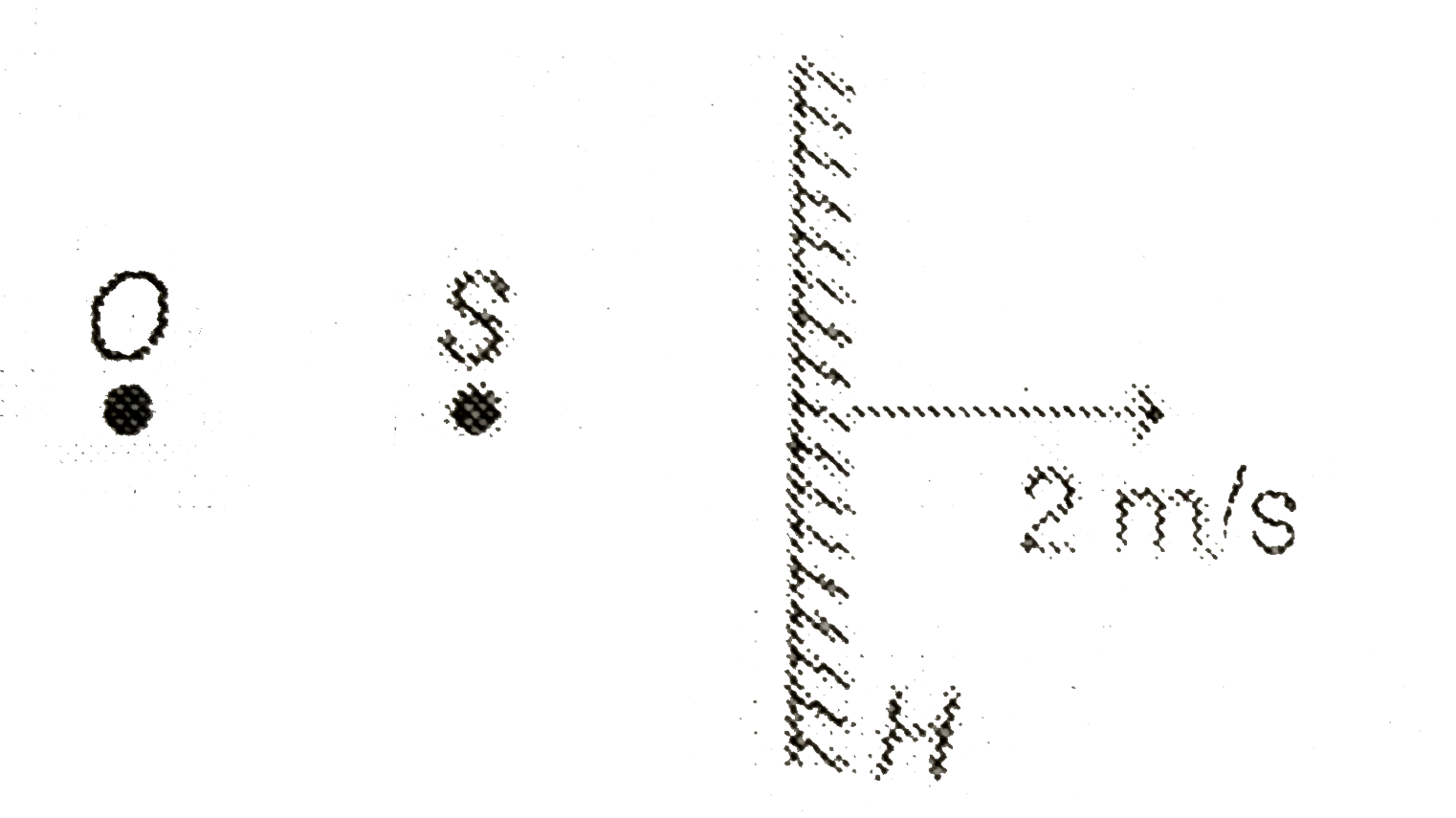 View Solution
View SolutionQuestion 153
Three component sinusoidal waves progressing in the same directions along the same path have the same period but their amplitudes are A,A2andA3. The phases of the variation at any position x on their path at time t=0are0,−π2and−π respectively. Find the amplitude and phase of the resultant wave. View SolutionQuestion 155
A man stands before a large wall at a distance of 50.0m and claps his hands at regular intervals. Initially, the interval is large. He gradually reduces the interval and fixes it at a value when the echo of a clap merges with the next clap. If he has to clap 10 times during every 3 seconds, find the velocity of sound in air.View Solution
All Exercises from AAKASH SERIES Class 12 PHYSICS WAVE MOTION AND SOUND
- EXERCISE (LONG ANSWER QUESTIONS)
- EXERCISE (SHORT ANSWER QUESTIONS)
- EXERCISE (VERY SHORT ANSWER QUESTIONS)
- EXERCISE (LONG ANSWER QUESTIONS)
- EXERCISE (SHORT ANSWER QUESTIONS)
- EXERCISE (VERY SHORT ANSWER QUESTIONS)
- EXERCISE (LONG ANSWER QUESTIONS)
- EXERCISE (SHORT ANSWER QUESTIONS)
- EXERCISE (VERY SHORT ANSWER QUESTIONS)
- EXERCISE (LONG ANSWER QUESTIONS)
- EXERCISE (SHORT ANSWER QUESTIONS)
- EXERCISE (VERY SHORT ANSWER QUESTIONS)
- PROBLEMS (LEVEL - I)
- PROBLEMS (LEVEL - II)
- PROBLEMS (LEVEL - I)
- PROBLEMS (LEVEL - II)
- PROBLEMS (LEVEL - I)
- PROBLEMS (LEVEL - II)
- PROBLEMS (LEVEL - I)
- PROBLEMS (LEVEL - II)
- EXAMPLE
- EXAMPLE
- EXAMPLE
- EXAMPLE

</a><a href=) View Solution
View Solution